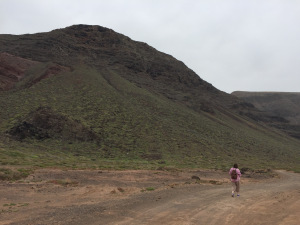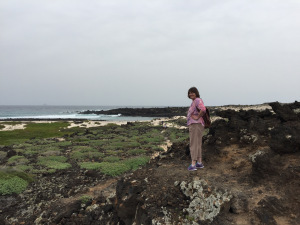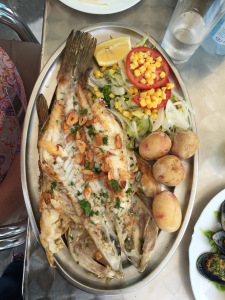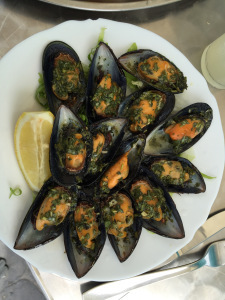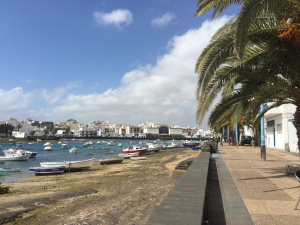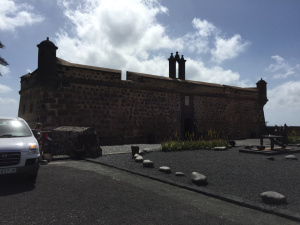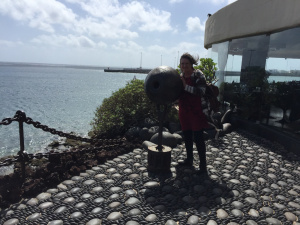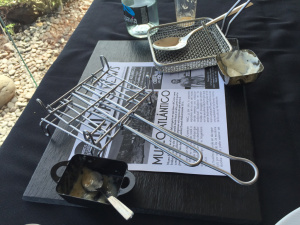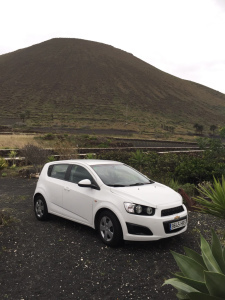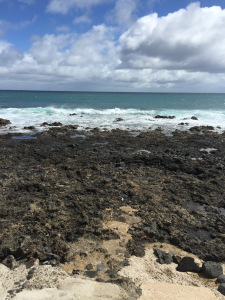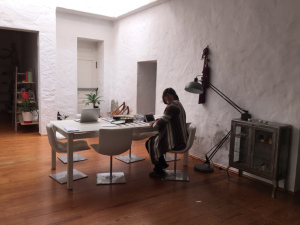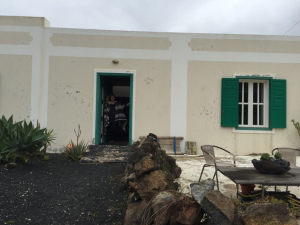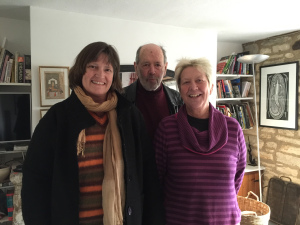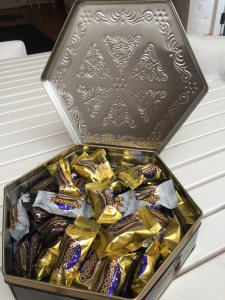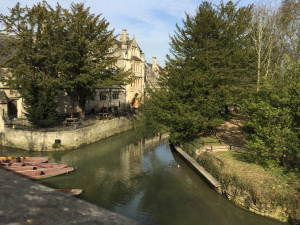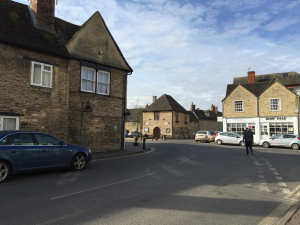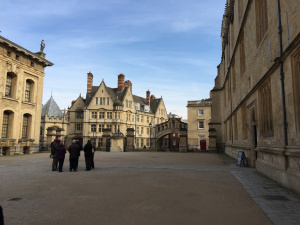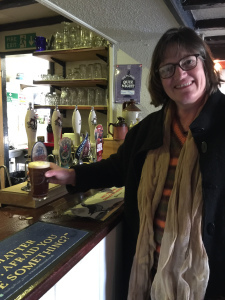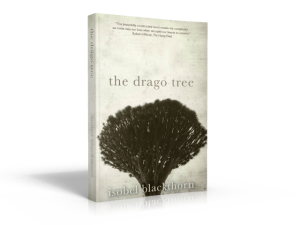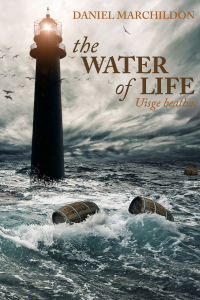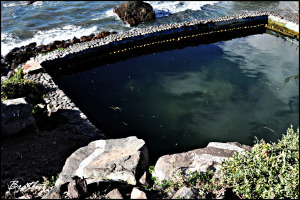Isobel Blackthorn's Blog, page 37
March 4, 2016
Picking up the breadcrumbs
Yesterday we took a tour of the island’s north, where the malpais (bad land) fans to the coast, the legacy of eruptions of a chain of volcanos about 5,000 years ago, two of which form the view from our farmhouse, to the west and the north. It is the route Ann took in the first chapter of The Drago Tree, only in reverse.
We set off, heading north to Ye, passing through a narrow valley between La Corona, the largest volcano in the chain, and the rounded peaks of the massif. The road is narrow and edged with low dry stone walls. Beyond, the fields of black were alive with euphorbias, the lichens on the rocks bright splodges of white, yellow and orange. Wild grasses and flowers everywhere, the result of recent rain. Usually, there is little green save what the farmers plant and tend.
Ye is the same as I recall. A tiny village forgotten by the developers. A string of farmhouses, a few ruins, paradise for someone like me.
We reached an intersection and headed right, skirting La Corona, the sloping plain to the ocean coated in a lava river, onces a tumbling fury, now a landscape of rugged basalt. For 6 kilometres we drove, taking the narrow lane to Orzola, twisting down between the rock, feeling the weight of it. A primordial scene, vast pillars of basalt protruding from the mass, nature’s standing stones. Everywhere a dance of colour, the lichens and euphorbias that have secured their grip on the landscape burdgeoning. The whole a sight at once painterly and alien.
And far more impressive than I recalled. No wonder Ann drove slowly, ‘consumed by what she saw.’
We arrived at the small fishing village of Orzola, which seems today to survive on passing trade to fill its string of restaurants, as tourists take the ferry to the island of La Graciosa nearby.
We parked beside a restaurant overlooking the harbour and took a short walk around the block. It was as if I had entered my only story, for Ann had been here, had gazed at the mountains and the cliff, had pointed out features to her companion, just as I was doing with Michelle.
And like Ann, we didn’t hang around. Instead, we headed to a remote beach to the west of Orzola, sandwiched by the cliff of El Risco. We pulled up halfway along a narrow track and walked the rest of the way. It was a walk like no other, each step bringing us closer to the barren massif, rising steeply, about 400 metres high, baring striations of rock, the jagged razorback of El Risco silhoutted against the sky, the whole a vast wall. The beach itself arcs to the cliff base, the creamy white sand strewn with basalt pebbles of all sizes. We stood in awe watching couples scattered here and there as they also stood in awe. Two guys were ignoring the warning signs and out on surfboards.
Walking to the car was strange. I wanted to walk backwards, to watch the cliff recede a little with each step. As if to say goodbye.
From Orzola we took the coast road to Arrieta, carved along the fringe of the lava flow. Small pebble strewn beaches appeared here and there. Beaches not for swimmers. For paddlers. For those wanting to stand and stare, at the ocean, the malpais, La Corona and the massif. For hours.
It’s a shared sentiment. Where I recalled when I was last here no human life other than me, there were cars and people. Not many. Not an amount to disturb. But to be thoroughly alone would mean either luck or a trek into the harsh rock of the malpais.
We found a small car park at one beach and stopped briefly, and walked to the shore, and I found a small pebble, the size of a bean, and pocketed it. I was being Ann, for she had done the same. It was as if I was walking in her footsteps, a bizarre feeling.
We completed our adventure with lunch beside the little wharf in Arrieta, choosing a restaurant with Spanish-speaking diners. We didn’t speak much. Both of us watched the ocean break on the low cliff to the south, sending up gushes of spume. Although I did comment on the fish I ordered, for it was the best fish I have eaten in a long time. And Michelle tells me her mussels were fine.
As if life were in agreement that I must return to this island, and stay not for weeks but months, I found a cheap apartment to rent, just metres from where we had sat on the wharf. It was Michelle’s doing. She wanted to check out the clothes in a boutique nearby, and as she browsed I took the chance to speak Spanish to the owner. How glad I am that I did! The woman spoke slowly and encouraged my efforts and when I explained my wish she told me of her apartment, of the cost, the location, and I knew that what I have been feeling for so long, a profound sense of belonging, was not an illusion, it was just me following life’s trail, picking up the breadcrumbs.
Filed under: Uncategorized Tagged: Arrieta, Canary Islands, El Risco, Lanzarote, Malpais, Odyssey Books, Orzola, The Drago Tree, Travel blog, Travel diary








March 2, 2016
Of the people…?
Yesterday we were up and out of this old farmhouse bright and early. A little cloud on a warm and breezy day, and as we drove down past the saddles of the massif on our way to Arrecife I noticed the swathes of untilled land, land that used to be a checkerboard of haphazard plots of maize, potatoes and especially prickly pear. In the 80s I would see old women in wide brimmed hats in amongst all those spines, as they plucked off the beetles for cochineal. No more.
The road is long and mostly straight, gone the hair pins, the meandering, the character. A road that bypasses the villages of Mala and Guatiza. A road determined to take drivers to the sprawl that now is Tahiche, and on down to the capital with its super-fast arc of ring road taking traffic to the tourist hubs of Puerto del Carmen and Playa Blanca in the south, and Costa Teguise immediately to the north.
We were heading to the port. An unusual choice perhaps, but it is also the site of the Castillo de San Jose and the museo of contemporary international art, one of a long list of sites for the sequel to The Drago Tree.
The port and surrounds, as anticipated, comprises numerous large concrete storage tanks, a power station (oil fired), a desal plant, containers stacked high in a low row along the waterfront, factories, warehouses, the whole drab grey-white of it set against the undulating sea. Scarcely worth a photo.
The castle, set amidst this scene, is one of three located on the sea front, built to ward off pirates. A small solid building, imposing, with a small dry moat in front and turrets on each corner. A building tucked back from the street and easily missed. A building no tourist would come across except by accident, or through the determination of the lover of fine art. In other words, not at all the sort of place of interest to the average tourist the island attracts. Besides, the other two forts, located along Arrecife’s promenade, are far better suited to tourist sensibilities.
Still, whoever commissioned the fort renovations was determined to create a sense of grandeur and importance, a place worthy of the high art it houses perhaps. The quick look I took inside confirmed the fort to be a remarkable setting for a gallery. The long and low first room, with its rounded arched ceiling, the steep stairs leading to chambers above and below, the slits in the thick walls, windowed – it had an air of secrecy, of low whispers. And it was empty.
Carved into the low cliff below is a restaurant, accessed via a curving flight of cobbled steps flanked by basalt boulders and plantings of succulents in deep picon.
We decided to sample the food, which proved good. And as we sat in front of a wall of glass, staring out at the containers on the waterfront, the buildings on the dock, I wondered what sort of people came here. Men in suits. This was a place for private conversations. A place from which to observe the docklands and not a pretty view. A place away from the noise and bustle of Arrecife. A hidden place away from the people. Not a place for tourists. Not a place for the peasant farmer plucking beetles off her prickly pear. And not a place for us.
Filed under: Uncategorized Tagged: Arrecife, Canary Islands, Castillo de San Jose, Cochineal beetle, Lanzarote, Odyssey Books, The Drago Tree, Travel blog, Travel diary








March 1, 2016
And the wind it blows
Well I cried on touchdown. It was the sight of the barren forms of the mountains of Los Ajaches, Lanzarote’s southern massif, and the villages of La Quemada then Puerto Calero coming into view, then the sprawling mass of white cubes that is Puerto del Carmen and the villages in its hinterland. Michelle had the window seat so didn’t notice my tears, but the woman seated to my right, who had been reading a Joanna Harris all flight, couldn’t have missed them. So I turned to her and said, ‘It’s my age.’
I hadn’t spoken to Bernie for the duration of the 4 hour flight, but once she had put down her book, I struck up a conversation, asking her where she was staying and the like. When she returned the inquiry, I hestitated. But the moment I mentioned I was an author and that I had written a novel set on the island, she took note of my name and the title and said she would buy my book straight away. Suddenly, I became aware of a new significance to my being here.
Michelle designated herself as driver. What a relief! I’m a good navigator so we managed to find our way round the capital, Arrecife, and on to the northern road with ease. And I could take in the mountains, the calderas, the ocean. The first thing that struck me was the size of the calderas, made all the greater by their closeness, something lost in a photograph.
According to all my internet searches all supermarkets are closed on Sundays save for those in the tourist south. And since we had driven past all of that and were in open country, our only hope seemed to be a petrol station for some basic supplies, and restaurant meals. We didn’t care that much, both keen to reach our destination, our farmhouse on the very edge of the village of Maguez.
When we neared the fishing village of Arrieta, I suggested we take a look. And there on the corner of the main road in, was an open supermarket! And down a narrow alley, the ocean…
Parking was fun, Michelle forced to drive down the narrow streets so typical of old Lanzarote, bereft of pavements and lined with low-rise dwellings, all whitewashed. She was doing well, having mastered the gear box, the indicators, the strangeness of finding herself on the wrong right side of the road.
The supermarket was well-stocked and had several aisles and a deli at the back. We bought locally grown produce, cheese, bacon cut to order on a meat slicer, wine, both local and Spanish, and other bits and pieces. It was all so inexpensive, so familiar to me. Atun (tuna backwards), champu (if you don’t know what that is, I can’t help you), leche semidesnatada (nata is cream), the whole experience of intuiting meaning came back to me. Along with a strong sense of belonging.
At the checkout I tried out my Spanish, with my usual apologetic caveat about not speaking the language for twenty-six years. Imagine the thrill when the woman smiled and chatted and I understood and she saw that I did, and we had a conversation. At the end she told me there was nothing wrong with the way I spoke. And there I stood; I’d come home.
I’ve come home to the mountains, the ocean, the wind, the ever present wind, to the palm trees, the lava, the buildings and, the people.
We loaded up the car and headed up the steep sided valley to the little plateau nestled in the mountains, the location of Haria, and Maguez. More narrow streets, this time a warren, but with the caldera of La Corona ever present in the north, it was easy to find our way.
It was when we arrived that we knew it had been more than worth the trek, not only across the globe, but the island too, for the house is magnificent.
Ten foot ceilings, walls of stone two foot thick, spacious rooms, and just for us. So I’m seated here at the large table, with Michelle opposite, the chocodate tin open between us, with the cool wind howling through the shutters, the scudding clouds releasing flurries of light rain, with all of our two week stay ahead of us, happy and fulfilled.
Filed under: Uncategorized Tagged: Canary Islands, Lanzarote, Odyssey Books, The Drago Tree, Travel blog, Travel diary








February 28, 2016
Hanging out in Oxford
This trip to Lanzarote wouldn’t have been complete without a detour to Oxford to catch up with my oldest friends! Sue Raikes and Adrian Moyes still live in the quaint village of Eynsham, six miles west of Oxford, where I lived back in 84. Introducing them to my travelling companion and publisher, Michelle Lovi was a delight.
The highlight of the flight was the refuel stopover in Dubai. Just two hours filled with queuing and shuffling about withe the carry on luggage, but it did prove just enough for Michelle to purchase a tin of Chocodates. I had no idea why she was on a mission to buy them until offered a free sample. An almond wrapped in a date and dipped in chocolate. One of those kinda healthy intensely sugary hits. Bit of a thing in Dubai it seems.
Landing in Heathrow and trekking to the coach, down endless walkways had me thinking of settings for horror or urban fantasy. But we were soon out of there and trundling through stop the green and twiggy fields of Buckinghamshire.
Arriving at Sue and Adrian’s cottage of old Cotswold stone it was as if I had never been away, the years shrunk to months, and everything I had known and loved about my visits was there again, in conversation, in the sumptuous food, created from produce grown on their allotment nearby, in the seamless way time fills with activities. Including a novel way of making coffee!
Yesterday Michelle and I took the bus to Oxford and I gave her my personal tour, following the route I used to cycle, down Broad St to Blackwells bookstore, a vast warren of a space filled with every sort of book, on round the Sheldonian theatre, past Bodleian library, under the Bridge of Sighs and along a back lane to Magdalen bridge.
Much had changed since I lived here in the eighties, but when I went into the old whole food store Uhuru to see if anyone there recalled the former CND office, I asked the woman behind the counter, I was amazed to find she’d been working there all this time and pointed out the site, now demolished to make way for a new building housing a few shops. One of them was Viny’s cafe on Cowley Road, unpretentious and lively and serving what we took to be North African fare.
That night Michelle had her first taste of Mah Jong. She picked the game up straight away, despite the wine and the jet lag. Impressive. Sue and Adrian bought my Mah Jong set for my fortieth. Fabulous game but requiring four enthusiastic players so I don’t get to play that much. I lost.
Our stay wouldn’t have been complete without a pub lunch. We went to The Plough in Finstock. Low ceilings, thatched roof, and traditional fare. I had bangers and mash, Michelle cod and chips. And oh what chips! Triple fried!
It was a terrific introduction to England. Michelle has remarked on the friendliness and generosity of all we met. Not at all what she anticipated. And we drove right by the location for Midsummer Murders.
Filed under: Uncategorized Tagged: Adrian Moyes, Book promotion, Chocodates, Cotswolds, Cowley Road, Eynsham, Finstock, Midsummer Murders, Odyssey Books, Oxford, Sue Raikes, Travel diary








February 22, 2016
taking flight
 Tomorrow begins a grand adventure, although it feels like it has already begun. I am flying to Lanzarote, Canary Islands after a twenty-six year absence, and I will be accompanied by my publisher, Michelle Lovi.
Tomorrow begins a grand adventure, although it feels like it has already begun. I am flying to Lanzarote, Canary Islands after a twenty-six year absence, and I will be accompanied by my publisher, Michelle Lovi.
And I have only met her once.
It is hard to say when this journey began. I could say it was the day I left my sleepy little village for Melbourne, a ten hour bus ride. But that is a trek I have done many times. Better to say this adventure had it’s beginnings back in 2013 when I conceived an idea for a book that would be set entirely on Lanzarote. That idea turned into The Drago Tree, a tragi-comic romance released by Odyssey Books in September 2015.
The novel has become my wings. I had been hinting on social media that I would love to return but it seemed like a pipe dream. After all, I hadn’t managed to visit after I left in 1990. Besides, I knew privately that I would never travel alone. I’m just not cut out for it. Months passed and The Drago Tree was launched. Then one day I posted how much I yearned to go back and I received a message from Michelle. It said, “Can I come?”
At first I thought she wasn’t serious. I said, “Yeah sure,” to be polite.
Two weeks later she repeated the question, which wasn’t a question at all. It was an offer of companionship and even though I had only met her the once, I wasn’t about to pass it up. Besides, Michelle is my publisher – what an honour that is! – and she has a sweet manner to boot. Perfect.
So we set a date and booked the flights and I have been saving my pennies ever since.
Tomorrow we fly to London. A couple of days later we will be on Lanzarote. And our adventure will begin. But of course it already has…
I will be blogging this special journey with lots of photos. My first ever travel diary. Travel with us if you wish and experience, albeit second hand, why Lanzarote is such an extraordinary island.
Filed under: Uncategorized Tagged: Book promotion, Canary Islands, Eco crime, Goodreads, Lanzarote, Odyssey Books, Publisher, Research, The Drago Tree








February 16, 2016
The Water of Life by Daniel Marchildon
In The Water of Life (Uisge beatha), a work of historical fiction, Canadian author Daniel Marchildon demonstrates a deep understanding of the turbulent history of Scotch whisky. Part celebration of Scottish pride and the legacy of English conquest, epitomised in the battle at Culloden and the devastating clearances that ensued, and part a depiction of the oft times ill-fated story of the Highland single-malt distilleries, The Water of Life sits alongside Mal Peet’s acclaimed novel Tamar as a thoroughly entertaining read. The reader is reminded of the scourge that is empire, and the wound carried in the hearts of those hailing from devastated lands, a wound passed down through the generations along with a treasured spiritual or cultural essence. In Scotland’s case this essence, held dear by so many, is spiritual in a literal sense, embodied in the spirit of whisky.
The story, spanning six centuries and following three interconnected bloodlines and two continents, Canada and Scotland, is triggered when descendent Elizabeth Legrand takes her first taste of the legendary Gleann Dubh and decides in a moment of reckless spontaneity to open her own distillery, making use of the pristine waters and sublime scenery of Canada’s Georgian Bay. Elizabeth’s story with its highs and its tragedies frames an epic narrative, one that serves to explain how it is that the whisky she imbibes has found its way into the cellar of her house.
Embedded in the secondary narrative is a fascinating and well-researched history of Scotch single-malt whisky, from its early genesis in the monasteries that supplied the Crown, through hardship and numerous catastrophes—not least the production of cheaper blended whiskies—to its present day status as one of the most revered spirits in the world. Thankfully absent from Marchildon’s engaging rendering is a tendency of historical fiction to slip into pastiche.
The story of Scotch, as depicted in The Water of Life, is one of lineage, the methods of distilling passed from father to son. Whisky might be the Highlanders’ weapon against empire, yet it proves all too often to backfire. Each generation faces its own tribulations, all of them the result of their reverence for whisky. The author sets alive these struggles, drawing the reader close to the drama through his mastery in conveying the emotions of his characters.
After a long moment, Robb saw his silhouette reflected in the water of the stream by moonlight. He splashed his face. The cold of the water and of the night pierced the veil of his drunkenness. He was still shaking, but from weakness and cold. Anger gradually gave way to clear-headedness, and he considered his situation with a calm, analytical eye. He wiped his mouth with the back of his sleeve. He couldn’t dispel the bitter taste, or the resentment that would, from now on, become part of the whisky he’d create.
Throughout the story, present and past are seamlessly interwoven in short alternating chapters, the reader led gently along, aided by the bloodlines’ family tree presented in the front pages. For a reader not adept at remembering names, this family tree proves a boon, as The Water of Life is rich with characters, each depicted with sympathy and flair. Even incidental characters are vividly portrayed. Although the real protagonist of the story is whisky itself, narrated through the lens of the primary characters, all of who share a devotion to the spirit that borders on religious zeal. The Water of Life is a story of passion, the author clearly enamoured with his subject, yet this can hardly be described a flaw. Written with an unassuming literary style, Marchildon’s prose is elegant and well crafted, his sensual appreciation shining through the story whenever one of the characters savours a taste of Gleann Dubh.
Fiery tongues lick the inside of his mouth, kiss him and make him tremble.
Countless examples of such luscious sentences are peppered through the narrative, commensurate with the experience of tasting truly fine single malt. It’s enough to make even the most hardened teetotaller wish she had a bottle and a glass by her side.
This whisky comes to her from another century, from a marriage, from a legendary crossbreeding, in fact. The fireworks exploding in her mouth spread all through her limbs, reaching her heart and her brain at the same time. This euphoria, both so sensual and so cerebral, makes her moan.
The need for foreshadowing in a story as complex as The Water of Life is transparent, the reader carried along through the unfolding dramas by a sense of anticipation. For some, this foreshadowing is perhaps a little overplayed. Yet this is a matter of style, and many readers would benefit from the dramatic accents that close each scene.
In all, The Water of Life is a superb novel. Upon reading the last sentence the reader is left feeling not only entertained and fulfilled, but with a vast knowledge of the history of something they may previously have known little or nothing about: Scotch whisky. The Water of Life lingers in the memory, a book to be savoured, like a dram of Gleann Dubh.
Marchildon’s novel warrants the literary merit awarded the original French edition by the Conseil supérieur de la langue française du Québec, when The Water of Life won the Émile-Ollivier literary prize in 2009. The work has been superbly translated by Märta Ziemelis.
The Water of Life (Uisge Beatha) by Daniel Marchildon was published by Odyssey Books in July 2015 and is available in paperback and ebook editions. 322pp $24.95. You can also find my review at the author’s website.
Filed under: Uncategorized








February 7, 2016
Praise for The Water of Life
January 1, 2016
Let my tell you about my muse
What is a muse? One of nine goddesses presiding over the arts, daughters of Zeus and Mnemosyne. Or a woman, or a force personified as a woman, the source of inspiration for the creative artist.
Using this latter definition, I can say that my own daughter Liz functions as my muse, as she certainly inspires me. But I prefer to think that she has a direct line into me, or that my muse, Scarlet, has a direct line out to her.
I named my muse Scarlet long ago, back when I had no idea who she was. All I knew was that she existed in my psyche and she was dangerous. Who is she?
I hold with Stephen King’s depiction of the nature of the muse in his memoir, On Writing. He describes his muse as a fat guy in the basement, smoking a cigar. Which all seems stable and almost businesslike, although I think that guy would be a controller. Just like Scarlet.
Here’s the story of Scarlet. I’m a survivor. Back when I was very small things happened that so terrified me that bits of me went into hiding, while other bits of me learned to cope. The first bit of me to flee was my muse, that inner self that lives deep in the unconscious, right in its centre, whose only purpose in life is to create.
The muse is the synthesiser, the one who puts all sorts of things together and comes up with something new. She or he is the bearer of inspiration and enormous joy. Those aha moments belong to the muse.
Without her, I was a creative cripple.
Scarlet fled into a dark corner of my psyche and over the years I locked her in a cage. I locked her in a cage because she could behave like a banshee. She had so much energy and it manifested as blind rage. I couldn’t deal with her. Frankly, she was embarrassing.
Every now and then she’d burst out of me and I’d write something, but I was ashamed of what I wrote. I had no confidence, no self belief, and the feedback I sought from others was not good.
She was persistent. Whenever there was a still moment in my life she’d rattle her cage. I’d feel compelled. I’d pick up a pen. Only to rip up or even burn the outpourings of song lyrics, poetry, stream of consciousness writing or part chapters of a novel.
Of course the life of a survivor is not an easy one. I had a lot to deal with both within myself and with the people I attracted into my life.
I battled with an absence of self worth. I even got a PhD thinking that would help, but it didn’t.
Thankfully I got some good advice along the way. And some of the therapy I underwent to make myself whole again was amazing. Through it I learned to recognise Scarlet and understand her needs. I found her to be a wild voluptuous woman who wore a long red gown as if she’d come straight out of Wuthering Heights. The crown of thorns she insisted on wearing a blatant statement of her suffering. Meek was not in her vocabulary.
Sometimes I visited the cage but the circumstances of my life meant I had to keep her under lock and key. I had no choice but to deal with the vicissitudes that had befallen me. She waited. The years rolled on. Then, in the forty-seventh year of my life, Scarlet had had enough.
On the day she broke out of her cage and roamed free I felt an upsurge of energy. Ideas for a book flooded my mind. I became edgy and impatient for change. She’d begun a revolution.
Before long she took over my decision making. She cleared out all the dross of my life. She demanded my full attention. I found her reckless and obsessive. But I let her have her way.
Now I’m fifty-four. I’ve lived for seven years with Scarlet’s ruthless resolve.
The entire contents of me have realigned themselves around this new creative centre. I feel her energy. She has me up at dawn. She has me writing every day. She has me pushing away everything that does not serve her needs. She sucks me inwards, into her realm, and I have become her slave.
In some ways I live a life out of balance. But in the scheme of my whole existence this extreme, out-of-balance way of life is simply bringing me to equilibrium. I would have it no other way.
Love you Scarlet.
Filed under: Uncategorized Tagged: art, art therapy, child abuse, creativity, fiction, inspiration, Isobel Blackthorn, Jung, muse, novel, Stephen King, survivors, transpersonal psychology, trauma








December 29, 2015
2015 in review
So, the WordPress.com stats helper monkeys prepared a 2015 annual report for this blog. Not bad… :)
Here’s an excerpt:
A New York City subway train holds 1,200 people. This blog was viewed about 4,200 times in 2015. If it were a NYC subway train, it would take about 4 trips to carry that many people.
Click here to see the complete report.
Filed under: Uncategorized








December 15, 2015
Crowdfunding Eco-crime novel La Mareta
It is true that when I meet someone I find a little curious for whatever reason, I study them, absorb them, listen to their stories with avid ears knowing full well a version of them will end up in one of my books. I feel like a vulture picking over others’ characteristics. Still, that makes me no different from any other author. I’m currently casting for La Mareta, so watch out!!
I’m also crowdfunding to help bring La Mareta to fruition. Your pledge will help me fund the research side of the project. Like its predecessor, the acclaimed novel The Drago Tree, this new novel is set on the volcanic island of Lanzarote. That’s over 40 hours travel time away! I’ll be hiring a car and driving around exploring the forts, castles, museums, galleries, caves, dams, wells, and of course, the maretas!
Here’s the Kickstarter campaign I’ve created. There’s a freebie giveaway for every pledge. I’ll be acknowledging all pledges in the book. Ever grateful. :)
Cheers!
Filed under: Uncategorized Tagged: crowdfunding, Eco crime fiction, Kickstarter, literary fiction, Odyssey Books, The Drago Tree











